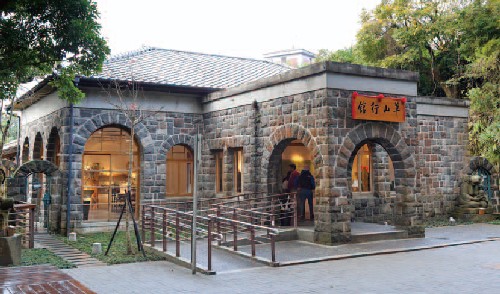The Veil Lifted Anew –Grass Mountain Chateau, Chiang Kai-shek’s First Taiwan Villa
The villa was specially built in the 1920s in anticipation of a visit to Taiwan by Crown Prince Hirohito, and in 1949, when ROC President Chiang Kai-shek first came to live on Taiwan, he chose the villa as his first residence, moving downhill six months later to today's Chiang Kai-shek Shilin Residence and using this site as his summer retreat. In 2003 the city's Department of Cultural Affairs began restoration work on the site, transforming it into a culturalarts salon. In 2007 a fire ravaged the facility, destroying everything but the main entrance, Grass Mountain Chateau In the grounds is a little tree-shaded path that leads you to an expansive wooden deck, stone gateway, and new board inscribed with the characters for“Grass Mountain Chateau.”Inside the entrance is Beyond the display space and dining facility in the reception room, sparkling views of the Guandu Plain far below can be enjoyed from under the eaves of the outside veranda. As you might imagine, this is a favorite spot with visitors. Elsewhere, check out the meticulous reproduction of the bamboo lath and wood lath on two exposed display sections in the indoor hallway, Before leaving, sit down in the dining area for a round of home-style“lion's head meatballs” and steamed sweet potato, one of Chiang Kai-shek's favorite dishes. And don't forget to take a quick look at the four other buildings elsewhere on the grounds, all originally residential units used by Chiang's retinue. One is now the home of 92 Art Center, an artexhibition space, and the other three buildings, smaller and numbered 88, 91, and 95, are used as studios for artists-in-residence and as cultural-arts spaces. The four add an element of colorful artistic flair to the elegant and reserved personality of this Yangmingshan treasure, where the interweaving of natural beauty, history, and art giving rise to a unique cultural oasis that has, literally, risen from the ashes. The ray s of spr i ng are begi n n i ng to warm Yangmingshan Park and the cherry blossoms are bursting open, so what better time to follow the path beside the park's No. 1 Car Park, where you'll come
The ray s of spr i ng are begi n n i ng to warm Yangmingshan Park and the cherry blossoms are bursting open, so what better time to follow the path beside the park's No. 1 Car Park, where you'll come
upon a refined Japanese-style villa named Grass Mountain Chateau, hidden away amongst cooling shade trees.
red-brick exterior wall, and entrance-area statue of Chiang. The city once again went to work, restoring the villa to its original glory using file photos, computer-simulation technology, traditional construction methods, and materials. The chateau doors once more swung open to the public on December 30th last year.
Information
Add: 89, Hudi Rd.
Tel: (02) 2862-2404
Hours: Tues~Sun (closed Mon), 10:00~17:00
(food service to 21:00)
Website: www.grassmountainchateau.com.tw (Chinese)
92 Art Center
Add: 92, Hudi Rd.
Tel: (02) 2862-2404
Hours: Tues~Sun (closed Mon), 10:00~17:00
the repaired coatroom, now a small gift shop offering many chateau-themed souvenir items. These include seasonal-theme items with a portrait of the Chiangs, plus Grass Mountain Chateau bookbags, and so on. Next is an expansive, brightly lit room with an attractive wood floor and large wood-frame windows, where late President Chiang entertained guests. Today the space is used as a gallery for the works of local Taiwan artists, and also houses a display guide on the local landscape and on the history of the chateau. The seats in the middle of the room have been made with the black, charred remains of the original ceiling beams, reminding visitors of the 2007 fire.
showing Japanese construction methods used in the 1920s. Jieshou Hall, at the rear of the building, is where Chiang Kai-shek met with his most trusted subordinates; today it houses a history display with vintage photographs, historical artefacts, and a documentary film on the chateau. Behind the hall is a wide, open porch built of timber where the first couple would sit for tea, have a hot-spring bath, or enjoy the scenery. Today thick foliage encloses the scene.

![Taiwan.gov.tw [ open a new window]](/images/egov.png)
